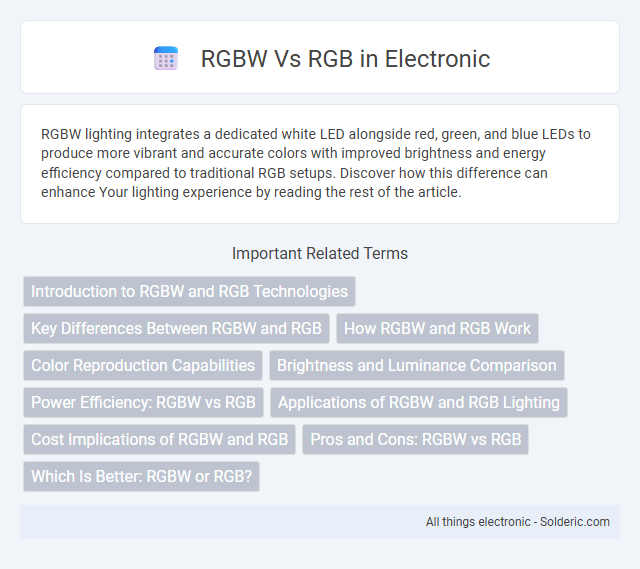RGBW lighting integrates a dedicated white LED alongside red, green, and blue LEDs to produce more vibrant and accurate colors with improved brightness and energy efficiency compared to traditional RGB setups. Discover how this difference can enhance Your lighting experience by reading the rest of the article.
Comparison Table
| Feature | RGB | RGBW |
|---|---|---|
| Color Channels | Red, Green, Blue | Red, Green, Blue, White |
| White Light Quality | Created by mixing RGB | Pure white LED included |
| Brightness | Lower white brightness | Higher brightness with white LED |
| Color Accuracy | Good for colors but less natural white | More accurate colors and better whites |
| Power Efficiency | Less efficient when displaying white | More efficient due to dedicated white LED |
| Cost | Generally lower | Typically higher |
| Common Uses | Basic color displays, general lighting | Advanced lighting, professional displays, better white representation |
Introduction to RGBW and RGB Technologies
RGBW technology integrates a dedicated white LED alongside red, green, and blue LEDs, enhancing color accuracy and brightness compared to traditional RGB systems that mix only red, green, and blue lights. This allows RGBW lighting to produce purer whites and wider color ranges, making it ideal for applications requiring improved color rendering and brightness. You can achieve more vibrant and natural lighting effects with RGBW, especially in environments where white light quality is crucial.
Key Differences Between RGBW and RGB
RGB displays use red, green, and blue LEDs to create colors, while RGBW adds a white LED to enhance brightness and color accuracy. The added white LED in RGBW allows for more vibrant and pure whites with lower power consumption compared to RGB. RGBW is preferred for applications requiring higher luminosity and energy efficiency, whereas RGB excels in color saturation and precision.
How RGBW and RGB Work
RGB uses three primary color channels--red, green, and blue--to create a wide spectrum of colors by mixing different intensities of each channel. RGBW adds a dedicated white channel alongside the red, green, and blue channels, enhancing brightness, color accuracy, and energy efficiency by producing pure white light without mixing colors. Understanding how RGBW works helps you achieve more vibrant and natural lighting effects compared to standard RGB setups.
Color Reproduction Capabilities
RGBW LED technology enhances color reproduction capabilities by adding a dedicated white LED, which produces purer whites and improves overall brightness without sacrificing color accuracy. Unlike standard RGB LEDs that mix red, green, and blue light to create white, RGBW offers enhanced color fidelity and a wider gamut through separate white light emission. This results in more vibrant and natural hues, especially in settings requiring true-to-life color rendering.
Brightness and Luminance Comparison
RGBW LEDs incorporate a dedicated white diode, producing higher brightness and improved luminance compared to traditional RGB LEDs that mix red, green, and blue light to simulate white. The addition of the white channel in RGBW results in more efficient light output and truer white tones, enhancing overall brightness without draining additional power. Studies show RGBW fixtures can achieve up to 30% greater luminance, making them ideal for applications requiring vibrant and well-lit environments.
Power Efficiency: RGBW vs RGB
RGBW LED technology incorporates an additional white diode alongside red, green, and blue diodes, resulting in higher luminous efficacy and lower power consumption compared to traditional RGB LEDs. By producing pure white light without combining all three colors, RGBW LEDs reduce energy usage while enhancing brightness and color accuracy. This increased power efficiency makes RGBW a preferred choice for applications requiring vibrant lighting with minimized electricity costs.
Applications of RGBW and RGB Lighting
RGBW lighting enhances color accuracy and brightness by adding a dedicated white LED, making it ideal for applications requiring precise color rendering such as architectural lighting, retail displays, and home ambiance. RGB lighting, combining red, green, and blue LEDs, is commonly used in entertainment systems, stage lighting, and decorative effects where vibrant, dynamic color changes are prioritized. Both technologies serve distinct purposes with RGBW optimizing color quality and RGB maximizing vividness and cost-effectiveness.
Cost Implications of RGBW and RGB
RGBW LED lights generally cost more upfront than RGB LEDs due to the added white diode, increasing manufacturing complexities and material expenses. Your energy consumption might be lower with RGBW since the white LED produces pure white light more efficiently than mixing RGB channels. Budgeting for maintenance and replacement should also consider that RGBW units can have higher long-term costs despite improved lighting quality.
Pros and Cons: RGBW vs RGB
RGBW LED lights offer enhanced color accuracy and brightness by adding a dedicated white LED, resulting in more vibrant and natural lighting compared to traditional RGB LEDs that combine red, green, and blue only. The inclusion of white LEDs in RGBW systems improves energy efficiency and allows for better pastel and white color rendering but may increase upfront cost and complexity in control. Your choice depends on whether you prioritize precise white tones and reduced power consumption (RGBW) or more affordable options with simpler color mixing (RGB).
Which Is Better: RGBW or RGB?
RGBW LEDs provide better color accuracy and brightness by adding a dedicated white diode, enhancing your lighting experience compared to standard RGB LEDs that blend red, green, and blue to approximate white light. Your choice depends on whether you prioritize pure white illumination and energy efficiency, where RGBW excels, or simpler, cost-effective color mixing found in RGB setups. For projects demanding vivid, true-to-life whites and greater versatility, RGBW offers superior performance without compromising on color vibrancy.
RGBW vs RGB Infographic

 solderic.com
solderic.com